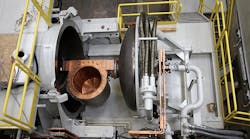Britain’s AMRC Castings, part of the Advanced Manufacturing Research Centre with Boeing at the University of Sheffield, reports it soon will start up the largest titanium melting and casting operation in Europe, one capable of producing 500-kg (1,100-lb.) castings, described as some of the world’s largest aerospace titanium castings. “We plan to create a world-class titanium casting capability in the U.K., developing the skills base necessary to enable companies to reap the rewards of carrying out a process that is very, very challenging,” according to AMRC Castings’ commercial manager Richard Gould.
AMRC Castings’ new furnace is part of a significant research and development effort to raise U.K. companies’ expertise for supplying large-scale titanium aerospace engine and structural programs. It is funded by the U.K.’s Aerospace Technology Initiative (ATI), Innovate UK, and the High Value Manufacturing Catapult. The goal is to ensure and maintain Britain’s retains its standing near the top of the global aerospace industry, and the largest in Europe. (The U.S. has the only other foundry operations capable of casting near-net-shape titanium parts weighing up to 500 kg, according to AMRC.)
In 2013, the Advanced Manufacturing Research Centre purchased Castings Technology International and its affiliate Titanium Castings UK Ltd., a research organization with members that include metalcasters, casting industry suppliers, and casting customers, with capabilities in casting design, material development and selection, manufacturing technologies, quality control, and testing and performance. Both CTI and AMRC are located in a research campus in Rotherham, which allowed AMRC to add casting technology to the range of its industrial research portfolio.
The new titanium melting operation includes two large-scale power supply units to provide energy for a new, Retech consumable-electrode casting furnace. The furnace’s melting capacity is 1000 kg, which allows it to pour up to 500 kg. With three interchangeable bodies, it is able to produce a variety of components for aerospace applications, some that portend finished weights that are 60 kg or more lighter than the established design.
Closed-loop cooling prevents the furnace structure from overheating. Hydraulic and pneumatic systems remove air from the furnace and casting chambers, which is critical to safe handling of molten titanium.
The furnace rotates to pour molten titanium into ceramic molds in the casting chamber below, which features a turntable that spins the mold at up to 300 revolutions per minute (i.e., centrifugal casting.)
Separately, a new plant is being installed to make ceramic mold shells up to two meters in diameter and 2.5 meters long, for finished parts weighing over 2.5 metric tons and suitable for the largest variants of aero engine intercases and other aerospace structures.
Furnace construction, followed by training and cold commissioning, will be completed this month. Hot commissioning and the first test melts are expected to be completed in December.
Initial casts will be poured into a static metal mold, followed by trials using static ceramic molds from the new shell-mold plant.









